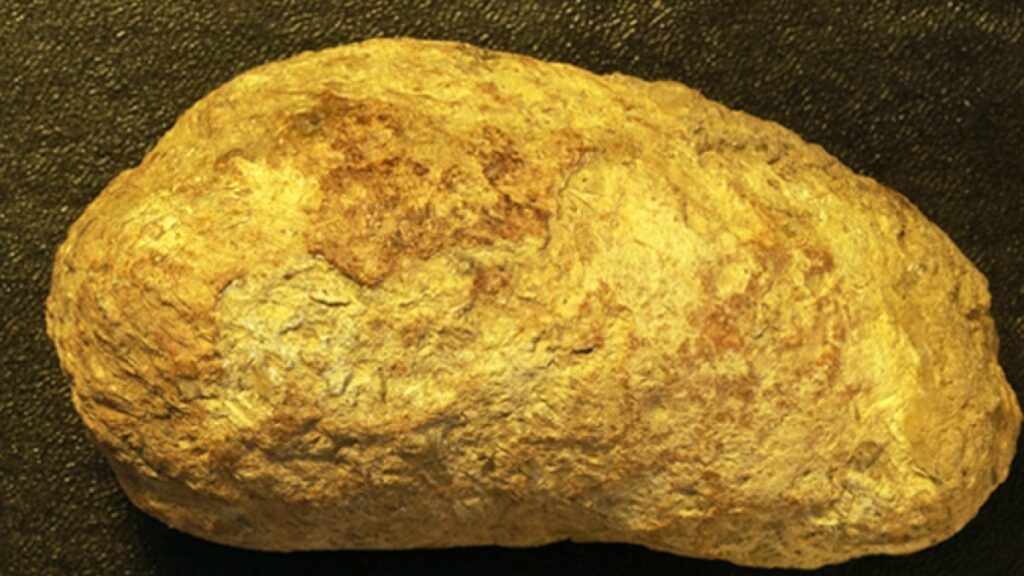
A surfeit of evidence in the form of fossilised dinosaur feces has put a little Indian village on the global map of dino research.

Indian palaeontologists and scientists have found an unusual concentration of dinosaur dung fossils in and around the village of Pisdura in India’s western Maharashtra state.
Since 2000, over “3500 coprolites (dinosaur excreta) studies have been undertaken”, said Dhananjay Mohabay, the deputy director of the Geological Survey of India (GSI).
“We found a treasure of evidence in fossils in this village and its surroundings”.
For the scientific community, the area is unique as “the dung mass has provided undoubted evidence of dinosaurs feeding off plants and excreting them”.
This has helped scientists conclude about the dietary habits of the dinosaurs and paleobotanical aspects of this region.
“This is spectacular as it is a site highly abundant with coprolites and other dino evidence including bones”, says Jeffrey Wilson, an associate professor at University of Michigan’s Department of Earth and Environment Sciences, who is collaborating on dino evolution research with Indian palaeontologists.
The excitement of the scientists has even enthralled the villagers of Pisdura, an otherwise little known village.
Kailash Ramlu has been helping the paleontologists for almost seven years.
“I had no idea what these [fossils] were. I thought they were simple stones and would wonder why these men from the city wanted them. But now having worked with them as an informal guide, I too have learnt about these creatures that lived here many years ago and have helped Dr Mohabey and his team. Many of my friends in the villages too have joined hands in helping the scientists by collecting rocks or taking them to the areas where eggs or rocks [are found].”
‘Dinosaur Village’
Since the late 1990s the study o fdinosaur dung has sped up, in part because of the wealth of information pouring in from Pisdura.
Pisdura has become known locally as “Dinosaur Village”. The village entered the dinosaur map way back in 1860, when the missionary and geologist Reverend Stephen Hislop, based in neighbouring Nagpur, first found a high amount of fossils on the surface in a field.
“The fossilised waste has helped scientists conclude about the biology of the animal that dropped them. These are fascinating fossils provide insight into the diet of extinct animals and the paleobiology of the Cretaceous period,” said Wilson.
The village today is primarily agrarian. The villagers grow mixed crops primarily sugarcane and cotton and in certain parts, wheat and rice.
“Today the local community is involved. Farmers and locals often lead us to fossil finds with the same excitement as palaeontologists,” said Mohabey.
It is not uncommon for the villagers and local tribespeople to find samples of fossils or bones, and deposit them for the scientists.
The entire exercise has not demanded deep excavation. Many of the coprolite fossils were found while ploughing the earth for farming when the soil is loosened for seeding and planting.
“Natural erosion across millennia has exposed the top layer where you can find sediments exposed with the ravages of time. Agriculture and cultivation practises have helped plough up these coprolites to the surface,” explained Krishna Ambwani, a scientist from Institute of Palaeobotany in Lucknow.
Predominantly herbivores
The high concentration of plant matter found in the morphology of the coprolite fossils have led scientists to confirm that the dinosaurs were predominantly herbivores, though some carnivores may have also lived here.
A number of fossils of coprolites contain plant evidence. “This is unique and provides undoubted evidence of dietary habits from the remains of plants in the dung mass coprolites,” says Mohabey.
These conclusions were “further strengthened” when the study of the teeth and jaw mechanism of these species was found to support the herbivore theory, said Ambwani.
The presence of water bodies like rivers and lakes in the arid Deccan plateau in India suggests that the dinosaurs might have also eaten water plants and grazed on grass.
Despite the arid and semi arid nature of this region the dinosaurs could have easily thrived here “as they were cold blooded reptiles that could survive eating small quantities of plant matter and did not demand luxuriant vegetation”, says Ambwani.
“The morphology of the dung [gives us] plant evidences, which are important as they signify the kind of environment these giant animals must have inhabited 65 million years ago,” Ambwani explained.
Continental drift
Long years of research by Indian palaeontologists have uncovered numerous dinosaur artifacts across the South Asian nation.
The predominant species found in India by scientists is those of Sauropod dinosaurs.
Sauropods were known to grow to a height of 100 metres and weigh over 100 tonnes. They looked like giant lizards with long necks and tails, and small heads.
According to paleogeography, Gondwana was a huge land mass that included India and other vast tracts of landmass of Africa, Madagascar, and South America, which gradually drifted apart.
Paleogeography studies reveal that important volcanic activity occurred during the Cretaceous period, destroying large parts of the region.
Scientists theorise that this could have led to the destruction of the dinosaur’s habitat, later causing their extinction in India.
The findings and works by Indian palaeontologists like Mohabey and Ambwani have found support from the scientific community outside of India.
“Our papers on paleobotanical aspects are well appreciated. Copies of research have been submitted to scientific research organisations abroad,” says Ambwani.
Mohabey’s recent project that began in 2003 found support and funding from international organisations. The GSI is partly supported by a grant from National Geographic and US based National Science Foundation to help with its research.
“The research by Mohabey also tells us about the kinds of plants that were in India 67 million years ago,” noted Wilson. “They signal discovery of modern grasses at that time in India.”




